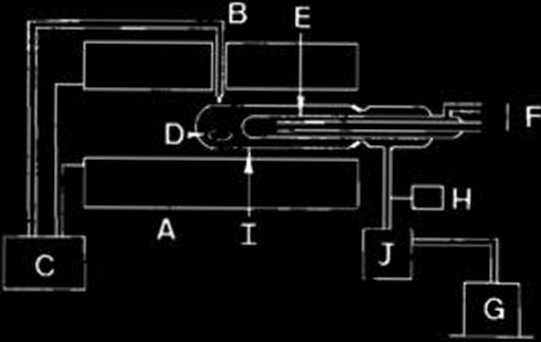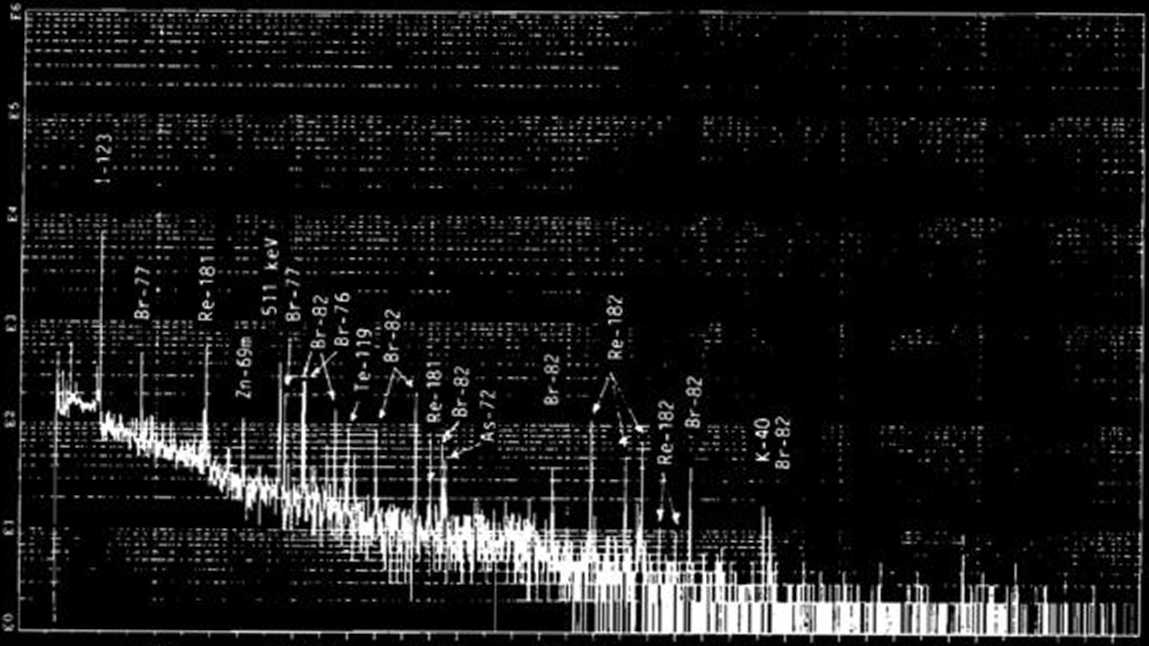372596246
72
RIKEN Accel. Próg. Rep. 24 (1990)
111*3-8. Dry Separation of Radioactive Nuclides from a Gold Target Irradiated with 135 MeV/u 14N lons
M. Iwamoto, S. Ambe, S.Y. Chen, Y. Ohkubo,
Y. Kobayashi, and F. Ambe

Fig. 1. Apparatus for dry separation. A, electric fumace; B, thermocouple; C, temperaturę controller; D, irradiated gold foil; E, cold finger; F, cooling water; G, rotary pump; H, Pirani gauge; I, quartz tubę; J, charcoal trap.
We started in this period a series of experiments on the preparation of multitracer Solutions from targets irradiated with heavy ions accelerated with RIKEN Ring Cyclotron.^ Solutions containing a large variety of radioactive nuclides are to be used in Chemical, geochemical, and biochemical investiga-tions. This report describes the separation of radioactive nuclides obtained from a gold target by heating under a reduced pressure.
A stack of gold foil was irradiated with a 135 MeV/u 14N-ion beam by using the falling bali irradi-ation system.2) A piece of the gold foil was heated at 1,050°C (melting point of gold: 1,064°C) in a
Fig. 2.
OO


Gamma-ray spectrum of the nuclides dissolved from the cold finger into (1:1) hydrochloric acid.
500 1000 1500 2000 2500 3000 3500 4000
CHANNEL
ąuartz tubę under a pressure of about 1 Pa (Fig. 1). The nuclides evaporating from the foil were col-lected on a Pyrex cold finger cooled with water. The finger was successively immersed into (1:1) nitric acid and (1:1) hydrochloric acid Solutions. The dissolved radioactive nuclides were identified by y-ray spectrometry with a pure Ge detector. The spectrum of the hydrochloric acid solution is shown in Fig. 2.
y-Ray spectra were analyzed by the Computer program BOB developed by Baba et al.3> The nuclides of following elements were found to have
been dissolved in acid Solutions:
(1:1) Nitric acid: Zn, As, Te, Tb, Re (1:1) Hydrochloric acid: Zn, As, Br, Te, I, Re A morę quantitative experiment is now in progress.
References
1) S. Ambe, S.Y. Chen, Y. Ohkubo, Y. Kobayashi, M. Iwamoto, and F. Ambe: This Remort, p. 73.
2) M. Yanokura, Y. Ohkubo, S. Ambe, M. Iwamoto, and F. Ambe: RIKEN Accel. Próg. Rep., 22, 150 (1988).
3) H. Baba: JAERI-M, 7017.
Wyszukiwarka
Podobne podstrony:
92 RIKEN Accel. Próg. Rep. 24 (1990)111-5. Instrumentation1. Design of a Microbeamline for a Compact
103 RIKEN Accel. Próg. Rep. 24 (1990)111-5-9. Test Experiment of the GARIS/IGISOL K. Morita, T. Nomu
116 RIKEN Accel. Próg. Rep. 24 (1990)111-5-19. Responses of Large Position-Sensitive Detectorsto Hea
11 RIKEN Accel. Próg. Rep. 24 (1990)111-1-2. Three a Disintegration of 12C in the Field of208Pb Nucl
63 RIKEN Accel. Próg. Rep. 24 (1990)111-2-28. Development of Nuclear Track Microfilters N. Nakanishi
80 RIKEN Accel. Próg. Rep. 24 (1990)111-3-16. Development of an lon Beam Sputtering Method toPrepare
63 RIKEN Accel. Próg. Rep. 24 (1990)111-2-28. Development of Nuclear Track Microfilters N. Nakanishi
94 RIKEN Accel. Próg. Rep. 24 (1990)111-5-2. Design of a Decay Muon Channel Using an Axially Symmetr
102 RIKEN Accel Próg. Rep. 24 (1990)111-5-8. Performance of Isotopic Separation in RIPS T.Nakamura,
105 RIKEN Accel. Próg. Rep. 24 (1990)111-5-10. Velocity Distribution of IGISOL lon Beams M. Koizumi,
108 RIKEN Accel. Próg. Rep. 24 (1990)111-5-12. Status Report of the RIKEN Swinger-Magnetic Analyzer
110 RIKEN Accel. Próg. Rep. 24 (1990)111-5-14. Test for Dispersive-Mode Beam Transportto the SMART
RIKEN Accel. Próg. Rep. 24 (1990)111-5-25. High Speed Serial Data Link for PC-9801 J. Fujita > PC
więcej podobnych podstron